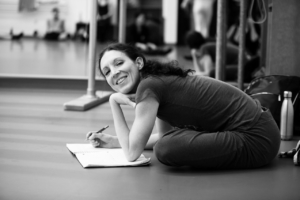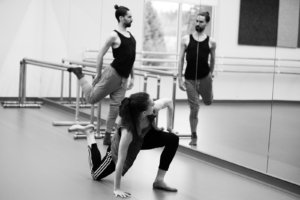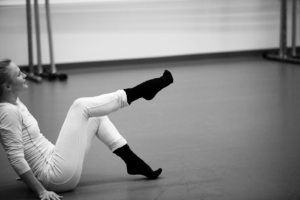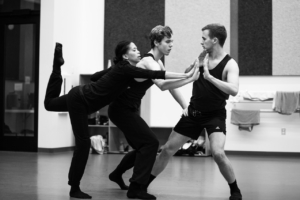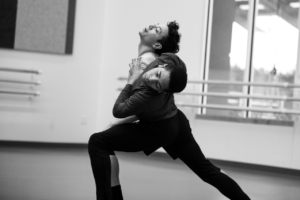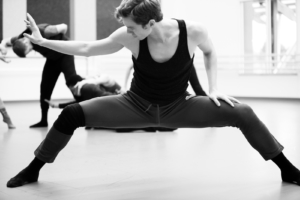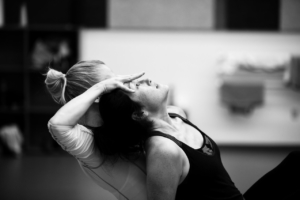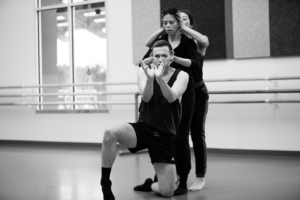Early on in the first rehearsal, last November, for what became Joinery—opening tomorrow as part of Whim W’Him‘s CONFIGURATE program—choreographer Gabrielle Lamb invoked some arresting images, showing as she told the dancers how to lie along the floor, the hand of her right arm up over her head, outstretched hand. “Feel how the palm changes to conform to the shape of what it’s moving over.” Putting her right hand on her knee, she continued, “Notice the surfaces contacting the floor. Let go. Connect more surfaces to the floor. Find the most efficient path to the other side, very much like an octopus on land.”
As she spoke, she got up and walked among the dancers who, along with Patrick O’Brien her helper and a member of her company Pigeonwing Dance, were continuing to embody her words. “Hands off the knee. Imagine spreading butter. You need to cover the waffle that is the floor. It’s different on a flat surface. What kind of contact? Get other parts—the curve of the neck—that would prefer to arch away from the floor. Extend the radius of the butter maybe 3 feet around you.”
“Shoulder, elbow, wrist have to work together.” Gabrielle who is exceedingly narrow, thin and flexible with a beautifully arched back. Although she says she has a hard time knowing what she’s going to do when entering the studio for the first time, each of her ideas is clear and detailed, as in an exercise where the dancers had to keep an imaginary water bottle spiraling in one direction around them, to the other hand, both hands, behind the back and so on.
“With the hand out of sight be aware of if it would be vertical. Now turn the imaginary bottle into an imaginary book and balance it on your foot. Then toss it to some other part of your body, even if that’s not actually possible. There’s a combination of mobility and stability that you have to attain.” Then she asks, “Within this, what makes you feel more like dancing. You may need to abandon a bit of the task—which is only there to find a new way of moving.”
As to the sources of the piece that premieres tomorrow (Jan 19, 2018), Olivier asked the other two choreographers to focus on love, compassion and empathy, as he was. During the process of creating, Gabrielle wrote to the dancers in December about her evolving thoughts.
- I knew that I wanted to work on ideas about breakage, from the point of view that broken things, people, and connections are worth repair. And moreover, that such repair/preservation is a shared effort. More than ever before, our society prioritizes youth, novelty and survival of the fittest. I wanted to present an alternative to that mindset.
- I started with the story of Neanderthal bones found in the Shanidar caves in Iraq. While we have been taught think of Neanderthal life as brutal and primitive, archaeologists found evidence that these people buried their dead in a ritual, ceremonial manner. One skeleton in particular showed signs of having been deformed and seriously handicapped at a young age, but also of having lived to a very old (for Neanderthals) age of 45—meaning that he would have been cared for and carried around for decades by the fellow members of his nomadic group. This goes against what we have learned to think about innate human behavior as brutal or selfish.
- The Neanderthals did not really end up making it into the piece, but the care they took of their society members led me to think about Kintsugi. Without knowing anything about Olivier’s piece last year, I was inspired by this Japanese technique that uses gold to repaired cracked and broken ceramics.
- Throughout the piece, connections and formations are shattered, rebuilt, and tested for resilience. I was also more conscious than usual of the negative spaces between bodies. This led me to read about the Japanese concept of “ma”, which is a literal translation of our word “space’. But it also means something like “gap, pause, or the interval between two parts”. This Japanese kanji “Chinese character” for “ma” 間 graphically combines 門 “door” and 日 “sun”. The earlier variant character 閒 was written with 月 “moon” rather than “sun”, depicting “A 門 door through the crevice of which the 月 moonshine peeps in.
- Finally, this last bit reminded me of a poem that comforted me at the time of the presidential inauguration. (From 10th century Japanese female poet Izumi Shikubu)
Although the wind
blows terribly here,
The moonlight also leaks
between the roof planks
of this ruined house.
So, in summary, ruptures can be repaired, and they can also open space for something resilient and unexpected to grow.
